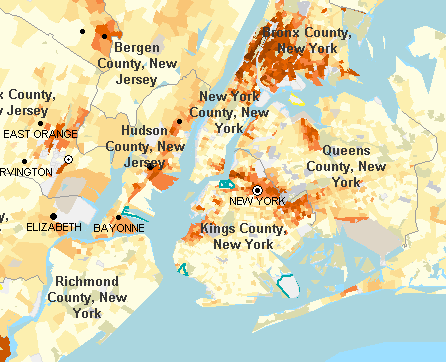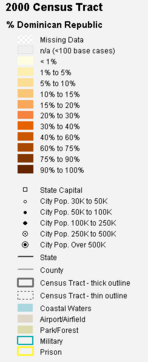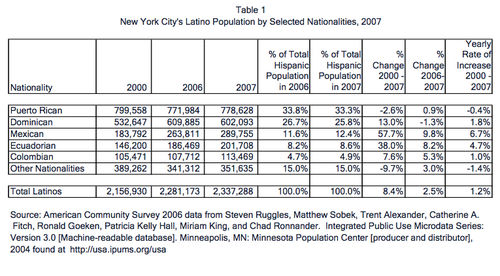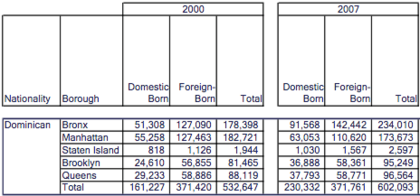DemographicsFrom From the Island to the City: Dominican Communities in New York City
Percent of Foreign Born Dominican-Republicans in NYC (Census 2000)
Dominican Population in NYCDominicans are New York City’s second largest Hispanic immigrant group. With 602,093 members according to the data released by the U.S. Census Bureau for 2007, among the Hispanic groups in New York City Dominicans are only outnumbered by Puerto Ricans, consisting of 778,628 members. The Dominican population accounted for 25.8% of the total Hispanic population of New York City in 2007, compared to 33.3% from Puerto Rico, 12.4% from Mexico, 8.6% from Ecuador, 4.9% from Colombia, and 15.0% from other nationalities. From the last U.S. Census in 2000 until 2007, the Dominican population has varied unexpectedly. First counted at 532,647 people in 2000, the Dominican population gradually increased, peaking at 609,885 in 2006, and then declining slightly to 602,093 in 2007 due to emigration from New York City and smaller numbers of foreign-born Dominicans entering the city. Overall, the Dominican population experienced a 13% growth during the period from 2000 to 2007, maintaining the status of Dominicans as the second largest Latino group in New York City. However, New York City is currently experiencing a marked change in the composition of the Latino community: the population of Ecuadorians increased 38.0%, the population of Puerto Ricans declined 2.6%, and the population of Mexicans increased 57.7%.[1]
Predicted Population ChangesIn order to better illustrate this change in New York City's Latino composition, here is a graph of the population projections among New York City's Puerto Ricans, Dominicans, and Mexicans: The most recent population data shows that Puerto Ricans currently have the highest population but are slowly declining. Dominicans have the second highest population and are slowly growing. The Mexican community, even though it is only the third largest Latino community in NYC, is growing rapidly. As the graph shows, if all three communities continue at their current rates of growth or decline, New York City's future demographic make-up will be vastly changed. Projections from this graph illustrate that by the Census 2020 New York City should already have a new Latino Community leading in population size, and by the Census 2030 another change is expected.[1]
Population Shifts Between BoroughsNew York City has experienced an intra-borough population shift as well: a large number of Dominicans have moved to the Bronx. By comparison, in 2000, Manhattan led in numbers with 182,721 Dominicans, followed by the Bronx with 178,398 Dominicans, 88,119 in Queens, 81,465 in Brooklyn, and 1,944 in Staten Island. By 2007, Manhattan had experienced a decline of approximately 9,000 Dominicans, while the Bronx gained about 56,000. Queens and Brooklyn both also experienced an increase in Dominican population, nearly 14,000 and 8,000 respectively, and Staten Island's Dominican population rose by 600, also a large change considering its total Dominican population. Another important fact provided by this table is the change in Domestic-Born versus Foreign-Born populations throughout the years. The data shows that much of the increase in the total Dominican population in New York City from 2000 to 2007 should be accredited to its Domestic-Born Population. Foreign-Born Dominicans have risen by only 341 people during that time period, while the Domestic-Born population grew by 69,105 people. Thus, this information indicates that Foreign-Born Dominicans are either emigrating from New York City at comparable rates to those immigrating into it, or the number of Foreign-Born Dominicans immigrating to New York City per year is minimal. The information also indicates that the number of second-generation Dominicans are growing fast, and their presence in NYC schools should be notable.[1] Dominican Socio-Economic StatusDominican socio-economic status in New York City is one of the lowest of the immigrant groups in the city. Out of the total Dominican households in the city, 31.9% made incomes below $14,999 (poverty line), while only 8.5% made incomes above $75,000.[2] These levels of income have put the Dominican annual per-capita household income in New York City below the Dominican average for the United States, which was $11,065 in 1999. The high percentage of Dominican families in poverty is a result of the types of family present in their communities. Many of the families in poverty are one-parent, female-headed families, resulting in fewer sources of income. In 2000, approximately 38.2 percent of Dominicans in New York lived in female-headed families, compared to 22.1 percent for the overall city.[3]
Education Levels of Dominicans in NYCAs reported in the 2000 Census, 49% of Dominicans 25 years or older had not completed high school and only 10.6% had completed college. However, second generation Dominicans are setting much better examples, with 60% of them having received some college education, and 21.9% completing college education. Dominicans in New York City have provided a great example of the significant increase in educational achievement among domestic-born Dominicans. In the city, Dominicans have high school retention rates that are substantially higher than for the overall Latino population. In 2000, they also had 111,553 children enrolled in the New York City public school system, making up 10.4% of the total student body in the city. In addition, 8.5% of the students in public colleges in New York City were Dominican.[3] This trend shows a probable change in labor force participation and income rates for Dominicans in the near future. References
|





